Examples of living lab projects
Waterloo has been doing living lab projects for nearly 30 years. Below are some recent examples of projects that took place on campus, for some inspiration.

Sticker design challenge
ERS 100 students developed their information literacy and critical thinking skills while addressing sustainability challenges. Students designed a sticker that promotes a specific sustainability initiative on campus such as pollinator gardens and the Eco-container and Eco-mug program. Students were encouraged to research, think critically, and communicate effectively while raising awareness about complex social and ecological issues.

Restoration in practice
Students from ERS 341 were tasked with tackling several restoration projects, including assessing effectiveness of biological control vs mechanical control of common buckthorn, building sediment mats to narrow over-widened sections of Laurel Creek, installing live stakes to reduce erosion, and developing planting plans to naturalize lawns and dense patches of invasive species across campus.

Waterloo in 2050
PLAN211 was tasked with producing visualizations of a net zero campus in 2050, considering electrification, active and sustainable transportation, clean energy production, and more. Groups selected outdoor sites on campus and visualized what the locations could look like when Waterloo's goals for sustainability and climate resilience have been met.

Re-imagining open spaces
Across University of Waterloo, there are many patches of open spaces ranging from natural, semi-natural to landscaped areas. Many open spaces identified on campus are patches of grass that provide minimal ecosystem services, while also requiring maintenance. PLAN405 students were tasked with developing a plan to re-imagine the existing open spaces while considering the need for leisure, recreation, and limited capacity for maintenance.

Urban water systems
The quality of storm water leaving campus during a flood is poor quality due to a lack of treatment to remove salts, suspended solids, and other pollutants. CIVE/ENVE 583: Design of Urban Water Systems students took this as a challenge and tried to find a way to reduce flood hazard and improve water quality. Ongoing research at this site is looking at the interaction between stormwater and trees as part of the Residential Scorecard for the Environment.

Transportation planning
As part of PLAN 405: Integrated Planning Project, student groups examined the demographic, geographic, and infrastructural factors that affect University of Waterloo employee transportation mode choices. The works identified key geographical areas with high access to sustainable transportation but low uptake, areas that lack access to sustainable transportation choices, as well as major non-infrastructure barriers to choosing transit and active transportation for commuting to and from campus.

Energy retrofit
As part of their engineering capstone, EMBODY consulting examined options for upgrading the exterior walls, windows, foundation and roof of our campus Court residences to achieve a net zero ready building. If implemented, these measures would ensure that over the course of a year, on-site solar PV energy production could offset the total energy use by the building. The report included energy modeling, detailed drawings of the upgrade measures, energy and cost-effectiveness analyses, as well as considerations for embodied emissions from materials and climate resiliency.

Stakeholder engagement
A multi-disciplinary student team embarked on a course-based project to develop a stakeholder engagement plan for the Sustainability Office. The plan was developed by mapping primary stakeholders, analyzing initiatives and engagement strategies being implemented by other institutions, and discussing strategies. The recommendations provided were focused on bridging the gap between collaboration and empowerment with internal stakeholders, with the ultimate goal of student-led initiatives driving climate action on the University of Waterloo campus.

Business case for naturalization
Fourth Year Environment and Business students were tasked with creating a business case for naturalization on campus. The findings from the survey indicated that people were willing to spend time in naturalized spaces, but many were unaware of such spaces on campus. Recommendations from the study include increasing engagement by hosting workshops to increase interactions with naturalized spaces.

Waste signage
To tackle the issue of cross-contamination in recycle streams, Shirley (Ya-Han) Yang conducted an action-based study, which later became her master’s thesis of Sustainability Management. Following the framework of Community-Based Social Marketing, she adopted a user survey, onsite observation, and waste audits to address the barriers and boost sorting behaviours to correct sorting. She then integrated her expertise and based on the collected data to design and test a set of new user-friendly and intuitive signage. The result is the colourful and very helpful signs now installed on the waste stations placed at different corners on the UW campus.

Lug-A-Mug advertising
Students in the Knowledge Integration program put together public service announcements promoting sustainable food choices available on campus. Vegan, vegetarian, locally-sourced, fair trade, MSC certified seafood, re-usable containers - there are lots of sustainable choices available. Food Services is taking their favourites and using these to develop promotional materials for use on our campus. Shown here is just one of many creative and amazing designs.

Eco-map
The Campus EcoMap is a project that outlines polygons delineating natural, semi-natural and landscaped areas on-campus in order to enhance biodiversity data collection and monitoring. The Sustainability Action Fund supported the hiring of three undergraduate students who conducted stakeholder interviews and document analysis to create the initial map. The EcoMap GIS files will serve as the basis for an on-campus biodiversity report and enable wide-scale collection and presentation of ecological data from coursework and other sources.

Waste Warriors
As part of their final capstone, Environment and Business students identified barriers to waste diversion in campus housing. Through a waste audit and survey, the students identified the need for more signage throughout the buildings, more information for incoming students, especially during orientation, and leveraging student ambassadors to foster positive, sustainable behavior.

Climate food labels
Fourth year Environment and Business students looked at how food labels could influence student food choices, specifically, if environmental impact of each food was provided. Through surveys and literature reviews, the group found that consumers prioritize ingredient list and nutritional content on labelling. They suggested the need to improve sustainability literacy amongst students in order to make food labels that include carbon footprint information more impactful.

Food carbon calculator
For their capstone project, Environment and Business students were challenged to create a carbon calculator, using the menu from Ev3rgreen Cafe as a case study. The students used transportation data such as distance of travel as well as type of transportation in their calculator. From their findings, they were able to collaborate with another capstone group to disseminate their results and display them as climate labels.
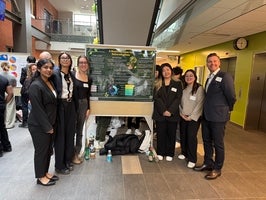
Green spaces and student fees
This study explored student perceptions and preferences towards increasing naturalized spaces on campus. Conducting a survey with 485 student responses revealed 90% support naturalization, and 62% were willing to pay at least $5 CAD as part of their school fees to support naturalization initiatives. Findings showed strong student interest in more naturalized spaces and a desire to connect with nature, informing a business case and education campaign for campus naturalization initiatives.
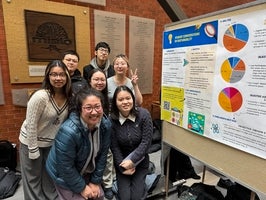
Sustainability relevance
As part of their final capstone, Environment and Business students were challenged with identifying ways to demonstrate how sustainability is relevant to all students across campus. The group suggested using social media and gamified apps to increase engagement, as well as addressing relevance gaps by using sustainability challenges in other capstone courses, and creating interdisciplinary teams to work on real-world projects.
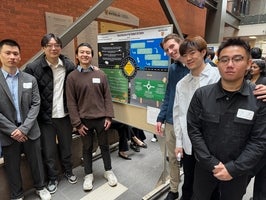
Waste diversion in SLC
Fourth year Environment and Business students sought to identify ways to improve waste diversion at the Student Life Centre - the largest social and food hub on campus. By evaluating existing infrastructure, and surveying students, the group suggested sign improvements with clearer labels, recruiting volunteers to help students sort waste accurately, raising awareness of the sorting guide, and using phone notifications and creating games to boost engagement.
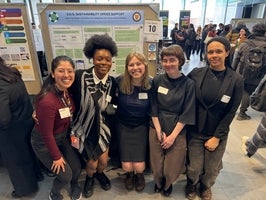
Explorers of tomorrow
In a 2024 survey, 30% of respondents were unaware of the Sustainability Office. To address this, an i-Capstone group held a one-day event in the Student Life Centre testing different methods of increasing engagement. They found that the main barriers preventing students from engaging with sustainability initiatives are lack of time and lack of awareness. Additionally, setting up educational games in high-traffic locations is the most effective method of increasing student engagement.
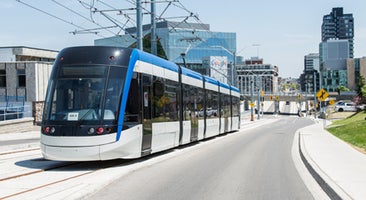
Intercity travel
Many Waterloo students travel to and from the Greater Toronto and Hamilton Area (GTHA). Yan Yu, as part of his Master of Arts on Planning, used surveys to identify the factors that affected whether students chose personal vehicle-based transportation versus bus or train options. The recommendations included setting up ticket vending machines closer to campus and encouraging more frequent direct bus or train service to the GTHA.
For more information regarding the projects listed, contact sustainability@uwaterloo.ca.